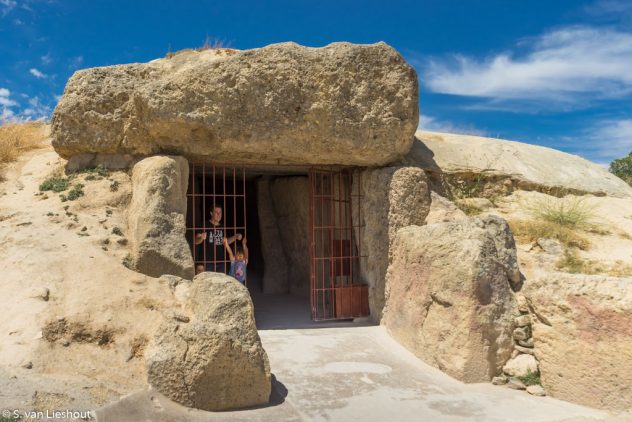The dolmens in Antequera are the Spanish equivalent of Stonehenge. These megalithic monuments were erected by the first farming communities, which settled in the Guadalhorce valley in the province of Malaga, in southern Spain.

Megalithic Monuments Antequera
As the dolmens are also called, the megaliths were built about 3,800 years BC, with giant stone blocks. It is only inside a tomb, the enormity of this operation becomes evident. In prehistoric times, on the border of the Stone and Bronze Age, a group of farmers made an effort to assemble these high rocks into burial chambers and temples with only some rudimentary tools and manpower at their disposal.
The buildings mostly blend into the landscape. At first, they resemble a cave. However, if you look in more detail, the rocks, roofs and pillars are recognisable. Indeed, these are structures built by human hands and not natural phenomena.
Prehistoric man did do his research before investing his valuable time in this piece of real estate. He likely consulted a Bronze Age broker, as everything here shouts:
“Location, Location, Location!”
A spectacular landscape
The surrounding landscape is truly spectacular. The Menga, one of the dolmens, overlooks the Peña de los Enamorados (Lover’s Rock). This rock probably had a symbolic meaning. The peña resembles the profile of a sleeping woman. When Menga was first opened in the 19th-century, archaeologists found hundreds of skeletons.
La Viera, the second structure, is also likely to have been a burial chamber. Still, at the opening of the dolmen, only tools were found.
The Tholos of Romeral, the youngest of the three, faces the limestone Torcal mountain. This dolmen is of later built, probably around 1800 BC.
The Dolmens a UNESCO heritage site
Menga, Viera and Romeral, together with the Peña (rock) and El Torcal, form the megalithic complex in Antequera. The area was declared UNESCO heritage in 2016. Peña de los Enamorados and El Torcal are classed natural monuments and the dolmens megalithic heritage.
Visit the archaeological site
The archaeological complex is open free of charge from 09.00 – 18.00 and on Sundays from 09:30 to 14:00. The visitor centre is closed on Mondays, January 1st and December 25th.
The centre has written information and a video in Spanish, Dutch, English, and French. Free tours can be booked in advance by telephone on +34 952 71 22 08.

The hiker (el caminante)

rock art female parts in Menga

The hiker (el caminante)

The tholos of Romeral

Peña de los enamorados
Practical information
Driving from Antequera, follow the signs. You will find Menga and Viera next to each other on the same plot. The address is Carretera de Malaga, 5 29200 Antequera. The tholos of Romeral is built on a separate site, a bit further down the road.
Accommodation
Hotel Plaza San Sebastian Antequera is a simple centrally located hotel in Antequera. It’s clean and cheap. The hotel does not serve food, but that is no problem as there are many cafés and restaurants within walking distance. To make a reservation or check prices, click here.
If you prefer something more luxurious than the modern four-star Parador is probably more appropriate. The hotel has a pool and is within walking distance of downtown. To check prices or to make a reservation, click here.
Torcal mountain, near Antequera
Do visit El Torcal, this is a spectacular karst mountain with strange rock formations. The Torcal mountain has been a protected area since 1929. The park is located north of the city of Malaga, in the municipality of Antequera. Because of the height and the isolated location, it is a good location for stargazing. The Astronomical Society organises regular meetings with a guide explaining the constellations.
An offshoot of Torcal is the beautiful Valle de Abdalajís.
Antequera
Antequera is a town about a 45-minute drive from the provincial capital Malaga. The historic centre has remains of ancient walls and a Moorish castle on a rocky outcrop overlooking the city. Other important buildings are the 18th-century Palace of Nájera and the Real Colegiata de Santa María la Mayor, the baroque church Iglesia del Carmen, the arena and the arc.
The city is accessible by train from Seville, Ronda and Malaga, Cordoba, and Granada.
For more information about Antequera, see the tourism website.
Restaurants in Antequera
In the centre of Antequera is plenty of choice of eateries for large and small budgets. The Plaza de Toros (bull ring) restaurant is located in an exceptional venue and offers good traditional cuisine.

The Antequera Arc

View on Antequera
More Spain
50 shades of green on the Via Verdes in Spain
Cycling along the ‘Vías Verdes’, the Spanish abandoned railways, is a fantastic way to explore the Spanish interior.
Valencia, a city break packed with the best
Valencia is an iconic Spanish city, known for its famous landmarks, food and ‘Las Fallas’, with a sunny climate and nearby beaches, wetlands and mountains.
Sendero el Saltillo, the Caminito del Rey of the Axarquia
Sendero el Saltillo also referred to as the Caminito del Rey of the Axarquia is a sensational hike ending at a canyon with a series of waterfalls.
Step by step guide how to get to Madrid Airport by train
Step by step guide how to get to Madrid Barajas airport in time by train via Atocha, using the AVE and short distance train C1.
See Malaga like a local with these 5 tips
Discover the real Malaga by going off the beaten track with these 5 tips.
